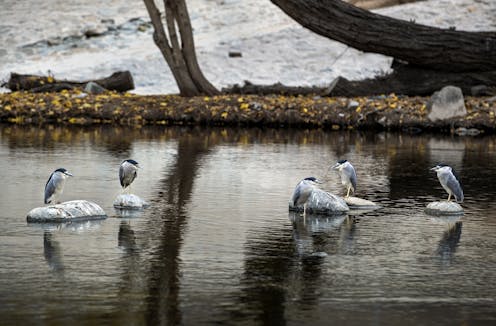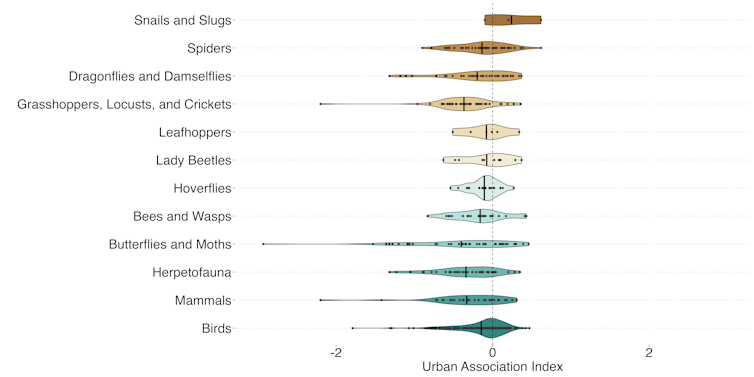Cities contain pockets of nature – our study shows which species are most tolerant of urbanization
Even in a concrete jungle like Los Angeles, wild species show up in surprising places. New research identifies the types of wildlife that best tolerate urban development.

The Earth is losing animals, plants and other living things so fast that some scientists believe the planet is entering its sixth mass extinction. But there’s some surprising good news: Urban areas may be key to slowing down or even reversing this crisis.
This idea may seem counterintuitive, since studies show that urbanization is a big driver of biodiversity loss. Cities alter the environment with artificial lighting and noise pollution, which affect many species. And urban land cover is expected to increase by 2.5% globally between 2000 and 2030 as more people move to cities.
As one measure of urbanization, half of the continent of Europe is less than 1 mile (1.5 kilometers) from a roadway or railway line. No location on the continent is more than 6 miles (10 kilometers) from these features.
But there are ways for cities to use nature-based solutions to slow species loss within their borders. At a major international conference on biodiversity loss in 2022, global leaders agreed to ambitious goals for restoring natural ecosystems across the planet, including targets aimed at “ensur[ing] biodiversity-inclusive urban planning”.
We are conservation and ecology researchers who work in Southern California and other settings. In our new study, we worked with colleagues to identify pockets within Los Angeles that host diverse native species communities. We even found that some groups of organisms seem to benefit from increased levels of urban development. And we developed a new metric for measuring how different species respond to urbanization, which city managers can use to develop local conservation strategies.
Wild Los Angeles
Los Angeles is a city of nearly 3.9 million people, with a heavily urbanized landscape that’s epitomized by its vast network of freeways and a mostly tame and channelized Los Angeles River. In the mid-20th century, car exhaust and industrial emissions produced thick smog that made going outside a health hazard and eventually spurred enactment of the 1970 Clean Air Act.
While smog does still regularly cloud the city’s skies, Los Angeles’s air is cleaner now than at any point in the past 50 years. And city leaders are setting ambitious targets for preserving nature across the metro area.
In the 2019 “Sustainable City pLAn,” then-Mayor Eric Garcetti set a goal of achieving no net loss of biodiversity by 2050 – in other words, preventing losses of living species or offsetting losses by adding new species. To track its progress, the city created a custom index to measure and assess biodiversity throughout Los Angeles. We helped to calculate a component of this index that measures the association of native species in Los Angeles with urbanization.
Los Angeles sits within the California Floristic Province, a global biodiversity hotspot. It’s one of 36 designated areas in the world containing high amounts of endemic plants – species found nowhere else in the world – and that have experienced significant losses of their original plant communities.
Even in the most urbanized parts of the city, Angelinos share the streets with bats, thousands of birds, and even large predators like mountain lions. But scientists don’t know yet exactly how levels of urbanization affect the wide variety of native animal species that call Los Angeles home.
Slugs and snails lead the pack
To support the city’s efforts to assess biodiversity and slow regional species loss, we collected data from iNaturalist, a free, publicly available app that anyone can use to identify and document observations of animals, plants and other living species. The app has amassed over 189 million records, and its data bank continues to grow.
We filtered this crowd-sourced data on species occurrence to control for the potential effect of observer bias – effects of how individuals choose to collect observations, which can show up in the data. For example, several people might upload observations of a single animal, making it seem as though multiple animals had been sighted. Or people might only upload observations from areas near roads, making it appear that wildlife was more abundant there, without looking for animals in more remote locations.
Our filtered dataset included over 500,000 observations recorded by 71,000 community scientists. This yielded occurrence records for 967 native species within about 93 miles (150 kilometers) of the city of Los Angeles. We modeled species responses to measures of urbanization and summarized the average response of all native species across the city.
Overall, we found that most native species were more likely to be observed in natural areas around Los Angeles than in urban parts of the city. One surprising exception was slugs and snails, which, on average, were more often found in urbanized zones than in natural areas. This finding mirrors a 2018 study in Tennessee, which also showed that native snail species can persist in highly urbanized environments – perhaps because people add water to parks and gardens for landscaping.
Across all native species in the study, butterflies and moths, as well as mammals, were least likely to be found in heavily developed areas. The absence of key host plants for particular butterfly species may explain why butterflies are relatively rare in highly urbanized areas.
For mammals, our findings are similar to a 2023 study conducted across the United States, which found that mammals, and especially large-bodied mammals, avoided extremely urban areas.

Even within the most urban zones, such as Pershing Square in downtown Los Angeles, we found some communities of species that favored natural spaces. Examples included house wrens (Troglodytes aedon) and urbane digger bees (Anthophora urbana).
This indicated that in some cases, cities can support native biodiversity. A next step for this research is to understand what underlying factors of the landscape might be drawing these native species in.
Making cities wildlife-friendlier
Our study demonstrates that pockets of biodiversity can exist even in the most urbanized areas of cities. The urban association metric that we created is meant to serve as a tool for city managers to develop strategies for encouraging wild species to continue to thrive in the city.
As one example, Los Angeles recently proposed an ordinance that encourages wildlife-friendly home construction. For example, housing developments with fences that don’t limit wildlife movement enable animals on the move to pass through.
Data from the iNaturalist app provides researchers with invaluable information about where native species occur and how abundant they are. Anyone who wants to contribute to conservation science can download it and record what they see on a walk, bike ride or ferry trip, or in their garden. You may find more nature in your neighborhood than you expect.
The authors do not work for, consult, own shares in or receive funding from any company or organization that would benefit from this article, and have disclosed no relevant affiliations beyond their academic appointment.
Read These Next
Midlife weight gain can start long before menopause – but you can take steps early on to help your b
What you do in the years leading up to menopause can help counter the natural hormonal effects of aging,…
New materials, old physics – the science behind how your winter jacket keeps you warm
Winter jackets may seem simple, but sophisticated engineering allows them to keep body heat locked in,…
Resolve to network at your employer’s next ‘offsite’ – research shows these retreats actually help f
Because they can help you get to know more of your co-workers, offsites may build the kind of trust…






